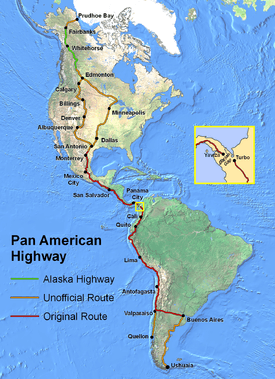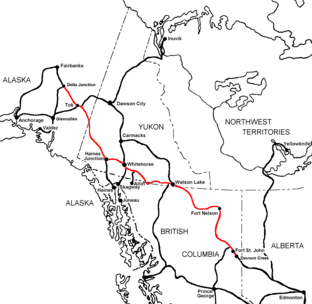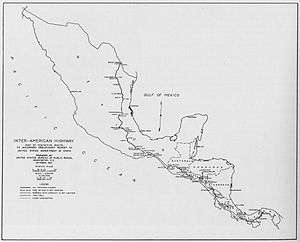Pan-American Highway (North America)
The Pan-American Highway route in North America is the portion of a network of roads nearly 48,000 kilometres (30,000 mi) in length which travels through the mainland nations of the Americas. No definitive length of the Pan American Highway exists because the Canadian government has never officially defined any specific route as being part of the Pan-American Highway, while in the United States, the Federal Highway Administration (FHWA) has designated the entire Interstate Highway System part of the Pan-American Highway System, although this has not yet been reinforced by any official highway signage.[1][2] Mexico officially has many branches connecting to various interstate highways at the U.S. border.

United States (Alaska)

The Pan-American Highway unofficially begins in Prudhoe Bay, Alaska near Deadhorse. Traveling south to Fairbanks, Alaska, the Highway follows the length of the Dalton Highway (Alaska Route 11) and Alaska Route 2. (Dalton Highway was the subject of the BBC's first episode of World's Most Dangerous Roads.[3]) From Fairbanks, Alaska's third largest city, the Pan-American Highway and the Alaska Highway are one and the same, following Alaska Route 2 southeast to the Canada–United States border southeast of Northway, Alaska, and adjacent to the Tetlin National Wildlife Refuge.
Note: The Pan-American Highway reenters the U.S., potentially in several locations along the U.S.-Canada border.
Canada
Yukon
Crossing the border into Canada, Alaska Highway 2 turns into Yukon Highway 1. The first significant settlement along the way is Beaver Creek, Yukon. At Haines Junction, where it meets Yukon Highway 3, Yukon Highway 1 turns east toward Whitehorse, the capital of the Yukon Territory.[4]
Through most of Whitehorse, Yukon Highway 2 and Yukon Highway 1 share an alignment. Yukon Highway 1 cuts southeast toward Marsh Lake, Yukon while Yukon Highway 2 cuts south to Skagway, Alaska. Eventually, Yukon Highway 1 intersects with Yukon Highway 8 and Yukon Highway 7 at Jake's Corner, Yukon; the Pan-American Highway continues on Yukon 1 east-northeast from this junction.
At Johnson's Crossing, Yukon Highway 1 meets Yukon Highway 6 and travels southeast through Teslin, Yukon. The Pan-American Highway continues on Yukon 1 as it crosses over into British Columbia (B. C.). After several miles, the Highway reenters the Yukon (once again as Highway 1) and continues southeast of Watson Lake until it, once again, enters British Columbia as B.C. Highway 97.
British Columbia
After travelling about 8 km (5.0 mi) past the British Columbia–Yukon border, the Pan-American Highway reaches the first settlement in British Columbia at Lower Post. After travelling about 32 km (20 mi) east, the highway once again re-enters the Yukon for roughly 8 mi (13 km). The Highway then re-enters British Columbia (as BC 97) for the final time. The Pan-American Highway continues south to southeast through a long uninhabited stretch until it passes through the villages of Fireside and Coal River, then runs east parallel to the Liard River.[5]
The Pan-American Highway continues on B.C. Highway 97 as it passes through Toad River Post, and then Summit Lake, which is nested between Stone Mountain and Mount Saint George. Further down the road, B.C. Highway 97 intersects with B.C. Highway 77; the Pan-American Highway continues along B.C. 97 east to Fort Nelson.
From Fort Nelson, the Highway travels south for about 290 km (180 mi) until it reaches Fort St. John. It continues on B.C. Highway 97 southeast for another 60 km (37 mi) to reach the end of the Alaska Highway at Dawson Creek.
Canada's length of the Pan-American Highway is neither official nor defined beyond the end of the Alaska Highway.
Alberta
After B.C Highway 97, the unofficial route becomes Alberta Highway 43. In approximately 7.2 km (4.5 mi), Highway 43 enters into the first settlement Demmitt. For about 75 km (47 mi), Highway 43 goes into Grande Prairie. At Clairmont, Highway 43, turns to Alberta Highway 2, Highway 43 goes left. Highway 43 goes for 455 km (283 mi) before reaching Edmonton. The unofficial route turns 2 ways, one way goes to Lloydminster, Minneapolis, and Dallas and merges with the second way. The second way goes to Calgary and the US Border.
United States (Contiguous)
Note: The Pan-American Highway is almost never referred to by name in the U.S. because of its correlation with the Interstate Highway System rather than any singular route.
In 1932, a bill introduced in the U.S. Congress proposed, among other roads, a route from Duluth, Minnesota, to Laredo, Texas, to connect with the Pan-American Highway in Mexico; this route probably followed today's Interstate 35. When the section of Interstate 35 in San Antonio, Texas was built, it was named the Pan Am Expressway, as it lies along this route. However, this route was never singularly named the Pan-American Highway.
Interstate 25 in Albuquerque, New Mexico, is named the Pan-American Freeway and it, along with part of Interstate 10 and U.S. Route 85, is officially part of the CanAm Highway.
U.S. Route 81 is claimed to be part of the Pan American Highway from Wichita, Kansas, to Watertown, South Dakota, where it runs separately from Interstate 29.
Interstate 69 from the Canada–United States border in Michigan to the Mexico–United States border in south Texas has been referred to as the NAFTA Superhighway which, when completed, will link to an official branch of the Pan-American Highway after crossing the border Laredo, Texas, and Nuevo Laredo, Tamaulipas.
Mexico
The Pan-American Highway unofficially has four terminals entering into Mexico. It is more generally known as the Inter-American Highway in that country and officially begins at the border crossing between Laredo, Texas, and Nuevo Laredo, Tamaulipas.

In Nuevo Laredo, the Mexican Federal Highway 85 splits into two routes to Monterrey, the alternate being the tolled Mexican Federal Highway 85D. Nuevo Laredo is considered Latin America's largest inland port with four international bridges into the USA.
Monterrey, the third-largest city in Mexico, is located 225 km (140 mi) from Nuevo Laredo. The Pan-American Highway continues south on Mexican 85, which is a divided limited-access highway until just past the village of Hualahuises. This is the beginning of an undivided stretch of the Pan-American Highway which parallels then cuts through the Sierra Madre Oriental mountains.
From Monterrey to Hualahuises is about 105 km (65 mi). The highway continues south as Mexico 85 for another 140 km (87 mi) until it reaches Ciudad Victoria. About 24 km (15 mi) past the village of Linares, the Pan-American or Inter-American Highway enters the state of Tamaulipas.
From Ciudad Victoria, the highway continues south as Mexico 85 for about 130 km (81 mi) to Ciudad Mante, and about 90 km (56 mi) further to Ciudad Valles. About halfway to Ciudad Valles, the Pan-American Highway enters the state of San Luis Potosí.
From Ciudad Valles to Zimapán is about 200 km (120 mi) of winding mountain road; Zimapán is in the state of Hidalgo. From Zimapán to the Hidalgo state capital of Pachuca is about 122 km (76 mi).
Upon entering Pachuca, the Pan-American Highway becomes again a divided limited-access route. About 40 km (25 mi) southwest of Pachuca, the alternate to Mexico 85 as it enters the state of México is the toll Highway 85D. The Teotihuacan ruins are near this segment of the highway. The highway continues another 32 to 40 km (20 to 25 mi) before entering the Mexico City metropolitan area in the suburb of Ecatepec de Morelos.
The Pan-American Highway (as Mexico Highway 85D) enters Mexico City,[6] but downtown Mexico City can be bypassed using Mexico Highway 136 (a divided limited-access route) and Mexico Highway 115, which reconnects to Mexico Highway 95D south of the Mexican Federal District.
As the Pan-American Highway continues south of Mexico City, it runs through the city of Cuernavaca about 48 km (30 mi) south of the Mexican capital. Here, the Pan-American Highway heads east along Federal Highway 190 through the state of Puebla; for about 32 km (20 mi), it is a limited-access divided highway. The route then reverts to an undivided highway and enters the state of Oaxaca. From Huajuapan de León to the Oaxaca state capital of Oaxaca is about 140 km (87 mi).
From the city of Oaxaca, the Highway continues southeast as Mexico Highway 190 for about 230 km (140 mi) to the village of Juchitán de Zaragoza. The Pan-American Highway is now in southern Mexico, which is a combination of small mountains, hills, and jungles. It is another 90 km (56 mi) to the border with the state of Chiapas where the Highway crosses the Continental Divide. From the Oaxaca-Chiapas state border, it is 160 km (99 mi) to the Chiapas state capital of Tuxtla Gutiérrez. The Highway then crosses the Mexico-Guatemala border at Ciudad Cuauhtémoc.
Guatemala
Upon crossing into Guatemala, Mexico Highway 190 becomes Central America Highway 1 and continues for about 80 km (50 mi) from the border village of La Mesilla to the city of Huehuetenango near the Maya ruins of Zaculeu. The Pan-American Highway crosses the Continental Divide again, and into the Sierra de los Cuchumatanes mountains.
From Huehuetenango to Chimaltenango is roughly 160 km (99 mi) with Mayan ruins at Iximché, just north of Tecpán Guatemala. From Chimaltenango, it is about 35 to 40 km (22 to 25 mi) to Guatemala City, the capital and largest city in Central America.
From Guatemala City to Cuilapa is about 50 km (31 mi) and another 55 km (34 mi) to Jutiapa. The highway continues as CA Highway 1 and approaches the border with El Salvador. It is 50 km (31 mi) to the border crossing at San Cristobal Frontera.
El Salvador
El Salvador is the smallest country (by area) along the route of the Pan-American Highway. After crossing into El Salvador at Candelaria de la Frontera, the Inter-American Highway continues on toward Santa Ana as Central America Highway 1. From the border crossing to Santa Ana is about 13 km (8.1 mi).
From Santa Ana it's about 45 km (28 mi) San Salvador, El Salvador's capital and largest city. At Nueva San Salvador, the highway passes near the Volcano de San Salvador.
From San Salvador to Cojutepeque is about 15 km (9.3 mi); following the highway southeast to San Miguel is about 65 km (40 mi). From San Miguel to the El Salvador-Honduras border is about 30 km (19 mi).
Honduras
From the border crossing to Nacaome is about 40 km (25 mi). Just past Nacaome is a highway traveling north to Tegucigalpa, the capital of Honduras. Traveling south, it is 40 km (25 mi) to Choluteca, the fourth-largest city in Honduras. From Choluteca to the border crossing, just past San Marcos de Colón, is about 68 km (42 mi). The Pan-American Highway's total distance in Honduras is about 148 km (92 mi).
Nicaragua
From the crossing at the Honduras-Nicaragua border, the highway continues as Central America Highway 1 to the town of Ocotal, about 42 km (26 mi). From Ocotal to Estelí is about 58 km (36 mi), and on to the village of Sébaco is about 46 km (29 mi). At this point, the Inter-American Highway turns from southeast to south towards Ciudad Darío, which is 15 km (9.3 mi) from Sébaco. From Ciudad Dario to the village of San Benito is 55 km (34 mi).
From San Benito, it is about 38 km (24 mi) to the Nicaraguan capital and largest city of Managua, on the shores of Lake Managua. From Managua south to the town of Jinotepe is about 50 km (31 mi), and Jinotepe to the town of Rivas is about 70 km (43 mi). Around this area the Highway is in view of Lake Nicaragua, which is the largest lake in Central America. From Rivas to the Nicaragua-Costa Rica border is about 35 km (22 mi).
Costa Rica
Costa Rica is the second-smallest Central American country in area after El Salvador. After entering Costa Rica, the Highway separates two national parks, the Santa Rosa National Park to the west and Guanacaste National Park to the east. From the Nicaragua-Costa Rica border to the town of Liberia is about 76.8 km (47.7 mi). In the region of Costa Rica, the Pan-American Highway runs just west of the Cordillera de Guanacaste (Guanacaste Mountains), which includes the active volcanoes of Rincón de la Vieja and Miravalles. While travelling through Costa Rica north of San Jose, the highway route is known as Costa Rica Highway 1 instead of CA Highway 1. From San Jose south to Panama, the highway route is known as Costa Rica Highway 2.[7]
Liberia to the town of Barranca is 120 km (75 mi) from Barranca, the Cordillera de Tilarán (Tilarán Mountains) can be seen from the Inter-American Highway. The Tilarán range includes Arenal, one of the world's most active volcanoes. From Barranca, the highway heads east across the mountains and the Continental Divide once again. From Barranca, it is roughly 77 km (48 mi) to the town of Alajuela.
After Alajuela the Cordillera Central (Central Mountains) come into view from the Inter-American Highway. The Central Mountains include four large volcanoes--Poás, Barva, Irazú and Turrialba. From Alajuela to San José is about 15 km (9.3 mi)
San José is the capital and largest city in Costa Rica. Leaving San José, the Inter-American Highway winds its way roughly southeast. From San José to San Isidro de El General is about 136 km (85 mi)
From San Isidro, the Cordillera de Talamanca (Talamanca Mountains) rise up from the rain forest canopy. The Talamanca range, which is non-volcanic, includes Cerro Chirripó, Costa Rica's highest mountain peak at 3,820 metres (12,530 ft). From San Isidro to Palmar Sur is roughly 122 km (76 mi), and Palmar Sur to the Costa Rica-Panama border is about 91.9 km (57.1 mi).
Panama
From the Costa Rica-Panama border to the village of La Concepción is about 20 km (12 mi), and from La Concepción to the city of David is about another 25 km (16 mi). The highway enters Panama traveling generally from west to east.
David, the capital of the Chiriqui Province, is located about 8 km (5.0 mi) north of the town of Pedregal and the Gulf of Chiriquí. From David, the Highway travels east about 90 km (56 mi) to Tolé. From Tolé to the town of Santiago is about 80 km (50 mi), about halfway to Santiago, the Inter-American Highway crosses over the San Pablo river.
From Santiago to Aguadulce is about 61 km (38 mi), where the Pan-American Highway (still CA Highway 1) reenters the tropical lowlands. From Aguadulce to Penonomé is about 48 km (30 mi). This stretch of highway crosses the Santa María river.
From Penonomé, the highway travels southeast, then northeast, then roughly north in a loop as it avoids crossing into Panama's Central Mountains. From Penonomé to La Chorerra is about 100 km (62 mi). From La Chorerra, it is only about 25 km (16 mi) to Balboa just west of Panama City.
Panama City is the capital and largest city in Panama. Before entering the city, the Pan-American Highway crosses over the Panama Canal on the Centennial Bridge, From Panama City, the Highway turns northeast. From Panama City to Chepo is roughly 55 km (34 mi); from Chepo to Cañita is another 25 km (16 mi).
At the village of Cañita is the old terminus of the northern route of the Pan-American Highway. The highway continues another 180 km (110 mi) past Cañita to the village of Yaviza, however, this stretch of highway is extremely remote. Yaviza is a village near the junction of the Tuira and Chucunaque rivers. It is here that the Inter-American Highway officially ends and, consequently, the northern Pan-American Highway. From Yaviza southeast lies the virtually-impenetrable Darién Gap, a 100 km (62 mi) stretch of rugged, mountainous jungle terrain.
References
- American Automobile Association, American Motorist, ca. 1974
- New Mexico State Highway and Transportation Department, State of New Mexico Memorial Designations and Dedications of Highways, Structures and Buildings Archived July 16, 2011, at the Wayback Machine, 2007, p. 14
- "Alaska, Series 1, World's Most Dangerous Roads - BBC Two". BBC. Retrieved August 6, 2017.
- "Yukon road map" (PDF). www.hpw.gov.yk.ca. Retrieved August 6, 2017.
- "Road map of British Columbia". www.hellobc.com. Retrieved August 6, 2017.
- "Road Tips." (Pan-American Highway). Go-panamerican.com. Accessed June 2011.
- "Archived copy". Archived from the original on June 27, 2010. Retrieved June 26, 2010.CS1 maint: archived copy as title (link)
Sources
- Plan Federal Highway System, New York Times, May 15, 1932 page XX7
- Reported from the Motor World, New York Times, January 26, 1936 page XX6
- Rand McNally Road Atlas, 1998 edition, p. 120, ISBN 0-528-83918-7
- Institute for Central American Studies – Costa Rica map
- Maps for DXers by Don Moore
- Road numbering systems by Marcel Monterie (links page)